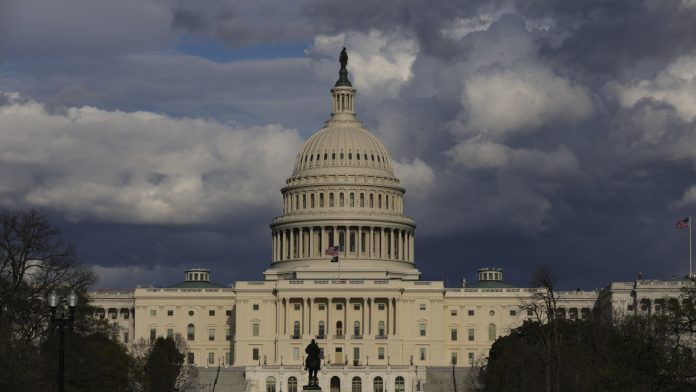Senate Republicans have approved a new framework for a sweeping multi-trillion dollar plan to address defense, energy, immigration and tax policy. Above, the U.S. Capitol is seen on March 31.
Bryan Dozier/AFP via Getty Images
hide caption
toggle caption
Bryan Dozier/AFP via Getty Images
After a flurry of overnight votes, the Republican-led Senate has approved a revised framework for a sweeping budget plan that is critical to President Trump’s domestic agenda.
The 51-48 vote in the early morning hours on Saturday brings congressional Republicans one step closer to finalizing a sweeping multi-trillion dollar plan to address defense, energy, immigration and tax policy.
“This resolution is the first step toward a final bill to make permanent the tax relief we implemented in 2017 and deliver a transformational investment in our border, national, and energy security,” said Senate Majority Leader John Thune, R-S.D., ahead of the vote.

Republicans in the House and Senate need to pass identical versions of a budget resolution in order to get access to reconciliation, a feature of the budget process that allows them to pass other policies and avoid a filibuster by Senate Democrats.
But they still face an uphill battle, as there are already signs of trouble in the House over details of the Senate framework.
Here is a quick look at what the Senate plan would accomplish, and what to expect in the days ahead as lawmakers move to the next phase.
An extension for Trump’s 2017 tax cuts
All together the Senate plan would allow for more than $5 trillion in tax cuts. The blueprint would extend the Tax Cuts and Jobs Act passed in 2017 under Trump’s first term. The program is set to expire by year end, which would mean a tax hike for millions of Americans.
The bill also provides for an additional $1.5 trillion in new tax cuts.
Republicans are hoping the new cuts can make good on several of Trump’s promises from the campaign, like no taxes on tips.
The House, by comparison, has passed a budget framework that sets aside $4.5 trillion for tax cuts.
Paying for tax cuts
One of the biggest differences between the Senate plan and the House plan is how to pay for tax cuts. The bill directs both chambers to cut the deficit through spending cuts. While the Senate spending cuts are set at just around $4 billion, the House intends to cut at least $1.5 trillion. That includes a directive to the House Energy and Commerce Committee to cut $880 billion in spending, which has raised fear that those cuts can’t happen without a significant hit to Medicaid benefits.




